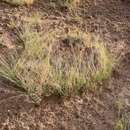Comprehensive Description
provided by North American Flora
Muhlenbergia pungens Thurb. Proc. Acad. Phila. 1863: 78
1863.
Podosafmum pungens Bush, Am. Midi. Nat. 7: 32. 1921, (Based on Muhlenhergia pungens Thurb.) Not Podosaemum pungens Link, 1827.
Perennial, with strong creeping rhizomes; culms erect from a decumbent leafy base, 20-40 cm. tall, sometimes taller, glabrous except the lower internodes, thin, the prophylla and the covered parts of the sheaths softly and densely lanate-pubescent; sheaths glabrous, except as noted above, crowded toward the base, much overlapping; ligule a ciliate membrane 1 mm. long; blades short, flat at base but closely involute above, firm, sharp-pointed, spreading, often curved, minutely pubescent on both surfaces, mostly 3-5 cm. long, sometimes as much as 10 cm., rarely longer; panicles long-exserted, open, oblong, 5-15 cm. long, the main branches 3-5, these divided into fascicles of capillary, finally spreading or divaricate, very scabrous branchlets, the whole cluster ascending, 5-6 cm. long, the capillary pedicels 2-3 cm. long; spikelets purple to brownish, 4—5 mm. long; glumes about one third as long as the spikelet, scabrous, often erose or toothed, the midnerve extending into a short awn; lemma terete, tapering into an awn about 1 mm. long; palea about as long as the lemma, the keels awn-tipped.
Typb locality: Rocky Mountains. Colorado (Hall & Harbour 632).
Distribution: Dry hills and sandy plains, South Dakota, Colorado, and t'tah to New Mexico and Arizona.
- bibliographic citation
- Albert Spear Hitchcock. 1935. (POALES); POACEAE (pars). North American flora. vol 17(6). New York Botanical Garden, New York, NY
Physical Description
provided by USDA PLANTS text
Perennials, Terrestrial, not aquatic, Rhizome elongate, creeping, stems distant, Stems nodes swollen or brittle, Stems erect or ascending, Stems geniculate, decumbent, or lax, sometimes rooting at nodes, Stems solitary, Stems terete, round in cross section, or polygonal, Stem internodes hollow, Stems with inflorescence less than 1 m tall, Leaves mostly cauline, Leaves conspicuously 2-ranked, distichous, Leaves sheathing at base, Leaf sheath mostly open, or loose, Leaf sheath smooth, glabrous, Leaf sheath and blade differentiated, Leaf blades linear, Leaf blades very narrow or filiform, less than 2 mm wide, Leaf blade margins folded, involute, or conduplicate, Leaf blades mostly glabrous, Leaf blades more or less hairy, Leaf blades scabrous, roughened, or wrinkled, Ligule present, Ligule a fringed, ciliate, or lobed membrane, Inflorescence terminal, Inflorescence an open panicle, openly paniculate, branches spreading, Inflorescence solitary, with 1 spike, fascicle, glomerule, head, or cluster per stem or culm, Inflorescence with 2-10 branches, Flowers bisexual, Spikelets pedicellate, Spikelets laterally compressed, Spikelet less than 3 mm wide, Spikelets with 1 fertile floret, Spikelets solitary at rachis nodes, Spikelets all alike and fertille, Spikelets bisexual, Spikelets disarticulating above the glumes, glumes persistent, Spikelets disarticulating beneath or between the florets, Rachilla or pedicel glabrous, Glumes present, empty bracts, Glumes 2 clearly present, Glumes equal or subequal, Glumes shorter than adjacent lemma, Glumes awned, awn 1-5 mm or longer, Glumes 1 nerved, Lemmas thin, chartaceous, hyaline, cartilaginous, or membranous, Lemma similar in texture to glumes, Lemma 3 nerved, Lemma glabrous, Lemma apex acute or acuminate, Lemma mucronate, very shortly beaked or awned, less than 1-2 mm, Lemma distinctly awned, more than 2-3 mm, Lemma with 1 awn, Lemma awn less than 1 cm long, Lemma awn 1-2 cm long, Lemma awned from tip, Lemma awns straight or curved to base, Lemma margins thin, lying flat, Lemma straight, Callus or base of lemma evidently hairy, Callus hairs shorter than lemma, Palea present, well developed, Palea membranous, hyaline, Palea about equal to lemma, Palea 2 nerved or 2 keeled, Stamens 3, Styles 2-fid, deeply 2-branched, Stigmas 2, Fruit - caryopsis, Caryopsis ellipsoid, longitudinally grooved, hilum long-linear.
Muhlenbergia pungens: Brief Summary
provided by wikipedia EN
Muhlenbergia pungens, the sandhill muhly or wickiup grass, is a variety of muhly grass which is found in the arid regions of western North America. It is named after the botanist Gotthilf Heinrich Ernst Muhlenberg.
It spreads by forming lateral underground stems and so forms clumps or tussocks. These are useful in binding dry, loose soil and so it may be propagated to stabilise slopes or control erosion. It has little agricultural use but may be eaten by foraging animals. It has been used by the Hopi of Arizona to make brushes.
Sandhill muhly grows in southwestern South Dakota, Kansas, southern Wyoming, Colorado, Utah, Arizona, New Mexico, and in the Texas Panhandle, as well as a disjunct station in Real County, Texas.
- license
- cc-by-sa-3.0
- copyright
- Wikipedia authors and editors

